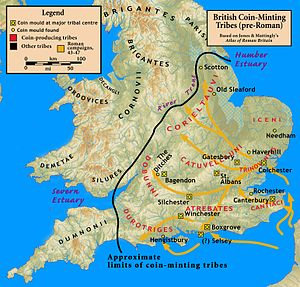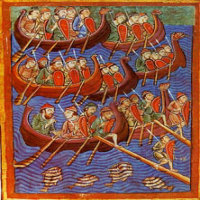Winsham before the Conquest
Early settlers must have found Winsham a very
attractive site - a valley slope facing south and sheltered from
the north by a high ridge (Windwhistle), with a river for water and
fishing. There would have been thick woods with plenty of game for
hunting: bear, deer, beaver, lynx, otter, hare (but no rabbits then)
and numerous birds. In other words, a comfortable place with plenty
to eat. Proximity to the sea was an advantage, for even in early
times there was trading of hides, metals and pottery. We have no
evidence of Winsham itself being inhabited at any time before the
Saxon period, but our knowledge of events in the south west taken
from Roman historians, from the Anglo-Saxon Chronicle (a yearly
record kept by monks) and other primary sources, enables us to
speculate soundly about what life must have been like here.
As the Celtic tribes expanded westwards
across Europe, driving out or absorbing indigenous people, they
began to farm. They cleared trees for long-term settlement and
enclosed fields, to reduce reliance on hunting, and planted crops.
Some small fields in Somerset and Dorset have the same boundaries
today. Many of our familiar wild plants provided food and were used
in healing.Nettles, for example, can be woven into a textile
as well as eaten, though clothing was mainly plaid-style woven wool,
dyed with plants such as madder.
The Romans
The Romans had their
eyes on Britain for some time, as a source of tin, copper, silver,
hunting dogs and slaves. When Claudius wanted to add lustre to his reign
he sent his commander Vespasian (later Emperor himself) to conquer it.
They landed in 43 A.D. and within a year had reached Maiden Castle,
where they heavily defeated the local tribesmen. This is near enough for
people living here to be aware of the powerful enemy approaching them.
Whether they were Durotriges (of Dorset) or Dumnonii(of Devon) they must
have seen the well-equipped and highly-disciplined troops, with their
red tunics and glittering bronze armour, marching west to establish the
fort at Isca (Exeter). The tribes frequently took refuge at one of many
nearby hill-forts such as Lewesden, Waddon and Pilsden.
As the Romans established control, the people of that Winsham must
have been aware of the building of the great road, the Fosse Way, that
linked Isca with Lindinis (Ilchester) and Aquae Sulis (Bath), and runs
past present day Street Farm (hence its name).
As the Roman
occupation became more peaceful and permanent, huge villas were built,
and local people would have worked for these landowners as farm workers,
as slaves stoking the hypocausts, or even, if they learned Latin, as
administrators. Many women became "wives" of the army veterans who were
granted land after 25 years' army service.

After
the recent (2001) finding of a previously unknown villa at Lopen, with
its beautiful mosaic pavement, and the already recorded villas at
Whitestaunton, Wadeford and South Chard, who knows what treasures are
still hidden underground? Simply ploughing a field or excavating for a
new building can lead to amazing discoveries.
When the Roman armies were withdrawn at the
beginning of the fifth century, the way was open for another
invasion: in this part of the country by the Saxons. They were
resisted by local warlords who had been raised in a Romano-British culture; some saw themselves as champions of Christianity against
Saxon paganism.
culture; some saw themselves as champions of Christianity against
Saxon paganism.
The origins of the King Arthur legend come from this
time (much embroidered in later centuries) though, despite the
claims of Tintagel, Cadbury and Glastonbury, no-one has proved that
such an individual ever existed.
What we do know is that the Saxons eventually made
their homes here and built a settlement. Winsham is a Saxon name,
meaning the holding or homestead of some one called Wine. The local
pronunciation of the village's name ("winsome") is therefore more
accurate than the commoner "win-sham". There was a Saxon church, though
unfortunately none of it remains.
|
|
The
arrival of Christianity
How Christianity reached Somerset is unknown:
traditionally the era began with the arrival of St. Augustine in
Canterbury (597 A.D.) sent by Pope Gregory, but the Celtic church is
much older. Our nearness to Cornwall, Wales and Ireland, makes it
possible that Celtic Christian influences came long before. Of course,
if the legend of Joseph of Arimathea planting the Glastonbury Thorn is
to be believed, then it was heard of even before that!
Stories apart, Saxon
society was established and continued until the Norman Conquest over
five hundred years later. It was a severely structured society, with the
thegns (thanes) who were the large landowners, at the top, and the
ceorls (churls) at the bottom. Everyone knew their place within the
hierarchy, whether they only tilled their small patch of land among the
common fields, and did two or three days work-service a week for their
overlord, or whether they were craftsmen in the village: smiths,
wainwrights (wagon-makers), potters, for example. The origin of so many
modern surnames is obvious. A higher position might be that of the
miller, or of the reeve (the village's chosen spokesman).
Justice was administered by the "hundred"
courts, in a complicated system of fines, such as the wergild (price of
a man) in cases of murder, and of trial by ordeal, where God gave the
verdict through water or the healing of wounds. Barbaric perhaps, but
accepted.
|
The Vikings
By the end of the eighth century, a new
threat arrived: Viking incursions. Originally the Vikings were
looters and raiders, carrying off cattle, slaves and anything else
valuable. We have no evidence that they ever came this far inland,
but news of their raids must have instilled fear all over the
country.

Winsham is not far
from the coast, north or south, and Somerset and Dorset were
especially vulnerable to invasions from Ireland, where Dublin was
a strong and rich Viking settlement. Excellent sailors , they dominated the shores of southwest England for many
years, making lightning raids from their long ships.
The Anglo-Saxon Chronicle records just how
near they came, for example:
875 A.D. ... Ealdorman Eanwulf with the
Somerset men, and Ealdorman Osric
 with the Dorset men, fought
against the raiding-army at the mouth of the Parrett.
(Burnham-on-Sea).876 A.D.
.... the raiding-army stole away from the West-Saxons
into Wareham, and then from Wareham to Exeter. They met a great
storm at sea, and 120 ships were lost at Swanage. with the Dorset men, fought
against the raiding-army at the mouth of the Parrett.
(Burnham-on-Sea).876 A.D.
.... the raiding-army stole away from the West-Saxons
into Wareham, and then from Wareham to Exeter. They met a great
storm at sea, and 120 ships were lost at Swanage.
The Saxons of Winsham cannot have been unaware, or unafraid, of
such events, even if they heard of them weeks later. Uncertainty
and rumour would have made things worse.
By this time, of course, King Alfred was marshalling opposition in
this part of the world. Elsewhere the Vikings (or Danes) had begun
to seize land and settle down, not just raiding in the summer.
After some failures in battle, Alfred withdrew to Athelney to
shelter and recoup his forces. Athelney (on the present A361 near
Burrowbridge) is less than twenty miles from Winsham: is it possible
that men from Winsham were sent to join his war-band? A difficult
journey across the undrained marshes of Sedgemoor, but some may
have thought it worthwhile.
By the year 1000, Danish kings ruled most of England, but in the
southwest loyalty was still to the Cerdingas, the descendants of
King Cerdic. These died out with Edward the Confessor, and the
struggle for the throne began. Were people here aware of Harold
Godwinson's ambition to be king? He rode to Bristol to cross the
Irish Sea to ask for Danish help, fighting the battle of Porlock
on the way back. But we all know what happened to him at Hastings
in October 1066, and the rest, as they say, is history.
|
|

